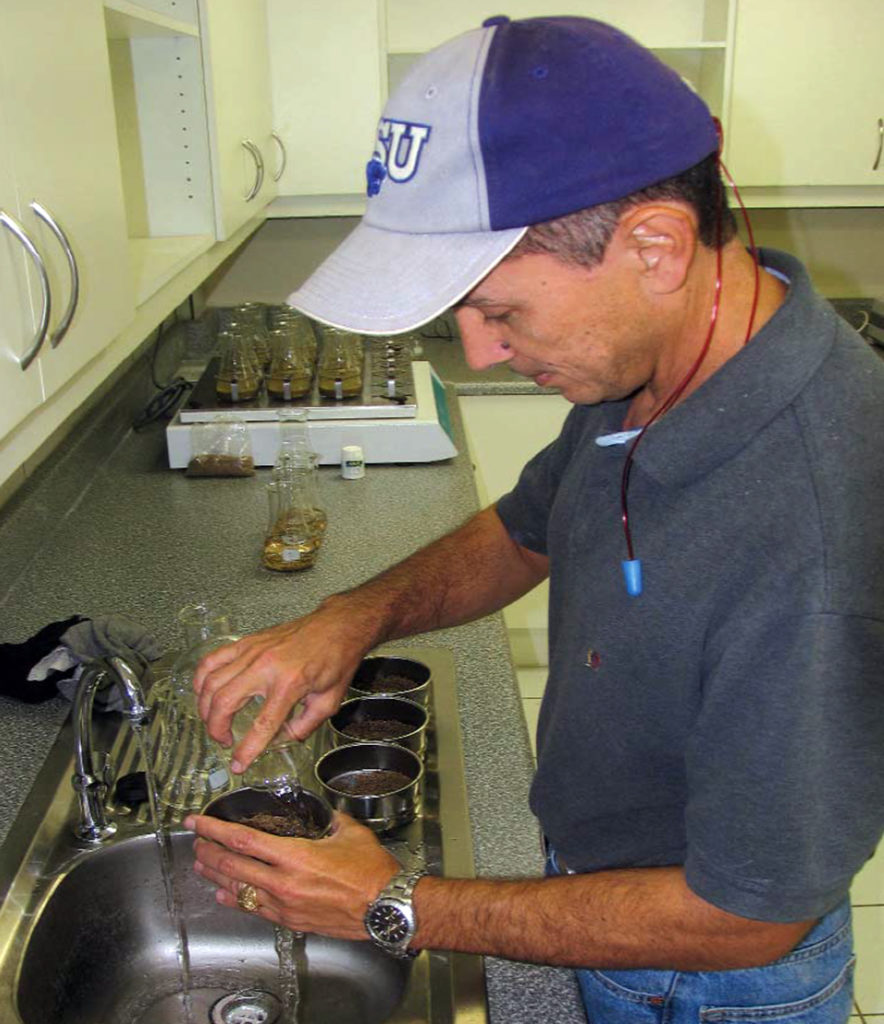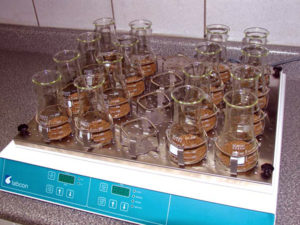Quantitative, replicable procedure eliminates subjective assessment of quality

One of the most important and discussed quality parameters of aquafeeds is their water stability. In the case of shrimp feed, hydrostability is important because pellets must maintain their physical integrity long enough for the animals to detect and consume them. Poor hydrostability leads to wasted feed and increased organic loading of ponds and effluents, higher feed conversions, and reduced profitability.
Regardless of the method used, hydrostability measurements must provide a quantitative and replicable procedure that eliminates the subjective assessment of quality. Measurable attributes can be used as quality controls to assure that manufactured feeds perform as expected at farms.
Assessment
At farms, water stability is often assessed in many different, subjective ways. One is by simply putting some pellets in a glass with water and observing how quickly they disintegrate or how much leaching occurs. Another method is to tie a pellet at the end of a string and submerge it in water until the pellet breaks into pieces or disintegrates. Others use their expertise in chop stick handling to pick up moist pellets to evaluate and determine how pellets maintain their integrity.
The reality is that none of the aforementioned methods is a quantitative way to determine water stability. They do not offer a repeatable and quantitative method that can be shared by feed manufacturers and the farmers or biologists in charge of assessing feed quality at farms.
The ways to determine water stability used by researchers are more expensive and require special equipment, but yield more accurate quantitative data. The following method is particularly recommended for shrimp aquafeeds.
Sample collection
Collect approximately 10 grams of feed every three or four bags until 20 samples are collected for a particular run. Mix the pellets together by hand to form a composite sample for water stability analyis. Weigh two 25-gram subsamples of the pellets and subject them to the laboratory procedure that follows.
Test procedure
Put 25 grams of prescreened pellets with fines removed in an Erlenmeyer flask and add 100 ml of fresh 25 degrees-C water. Clamp the flask snuggly in an orbital agitator and run the agitator at 200 rpm for 30 minutes. After agitation, place the pellets on a No. 20 mesh screen and wash the fines off with tap water. This step will remove any fine pieces that disintegrated during the agitation and are smaller than the screen size.
After washing, allow excess water to drip off for several minutes. Place the screen in a convection oven for two hours at 130 degrees C, then remove it to cool to ambient temperature. After cooling, record the weight of each pellet sample.
Calculations of water stability
Begin with the formula:
![]()
Multiply the result by 100 to convert to a percentage. The percentage number then needs to be corrected for the moisture content of the initial sample. Therefore, it is necessary to know the moisture content of both the initial pellet sample and that of the dried pellet sample.
Example: If the initial moisture content of a product is 11 percent, and the moisture content of the final sample is 2 percent after drying, adjust both weights to an equal basis. The moisture is 11 minus 2 or 9 percent. Therefore, add 9 percent back to the dried product or multiply the final result by 1.09.
- Sample weight = 25 grams
- Final sample weight = 18.5 grams
- Moisture of initial sample = 11 percent
- Moisture of final sample = 2 percent
- Water stability = (18.5/25) x 100 = 74 percent
- Correction for moisture = 74 percent x 1.09 = 80.66 percent.
Interpretation of results

After values are obtained, how does a final value of 70 or 80 percent correlate with water stability? Higher percentages indicate higher feed water stability, since the values obtained indicate how the pellets hold their physical integrity after being subjected to the test treatment.
The amount of dry mater loss will vary depending on the formula. Feeds lower in protein – and higher in starch – have higher water stability values than feeds with high levels of protein and fat. As a guide when using the method described here, feeds with 35 percent crude protein and at least 30 percent starch should have a water stability of 80 percent or higher after one day of manufacture. Feeds with 40 percent crude protein and 6 to 8 percent fat should have a water stability of 75 percent or higher, and feeds with 45 percent crude protein and 8-10 percent fat should have 70 percent water stability.
The hydrostability of shrimp aquafeed formulas can be improved by increasing the levels of natural or artificial binders, or optimizing processing conditions by preconditioning mash moisture and temperature, and adjusting postconditioning residence time and temperature, pellet die working area, and meal particle size.
(Editor’s Note: This article was originally published in the December 2005 print edition of the Global Aquaculture Advocate.)
Now that you've finished reading the article ...
… we hope you’ll consider supporting our mission to document the evolution of the global aquaculture industry and share our vast network of contributors’ expansive knowledge every week.
By becoming a Global Seafood Alliance member, you’re ensuring that all of the pre-competitive work we do through member benefits, resources and events can continue. Individual membership costs just $50 a year. GSA individual and corporate members receive complimentary access to a series of GOAL virtual events beginning in April. Join now.
Not a GSA member? Join us.
Author
-

Eugenio Bortone, Ph.D., PAS, Dpl. ACAN
1521 Country Club Drive
Red Bay, Alabama 35582 USA
Tagged With
Related Posts

Aquafeeds
A look at protease enzymes in crustacean nutrition
Food digestion involves digestive enzymes to break down polymeric macromolecules and facilitate nutrient absorption. Enzyme supplementation in aquafeeds is a major alternative to improve feed quality and nutrient digestibility, gut health, compensate digestive enzymes when needed, and may also improve immune responses.

Aquafeeds
A look at the SME controlled extrusion process
A study was conducted using a Twin-Screw Extruder equipped with Specific Mechanical Energy (SME) and Density Control valves, to determine the effect of SME on the water stability of shrimp feeds. Further research is needed to evaluate the performance.

Aquafeeds
Least-cost formulation software in shrimp aquafeed production
The use of properly and efficiently formulated feeds using least-cost formulation software is an important determinant of a successful crop.

Aquafeeds
Shrimp feeds depend on proper ingredient grinding
The proper feed particle sizes of aquafeed ingredients are established by the nutritional requirements of the species targeted and by the feed manufacturing process used. For proper ingredient particle sizes, various characteristics are very important, including particle size distribution and pellet density.

